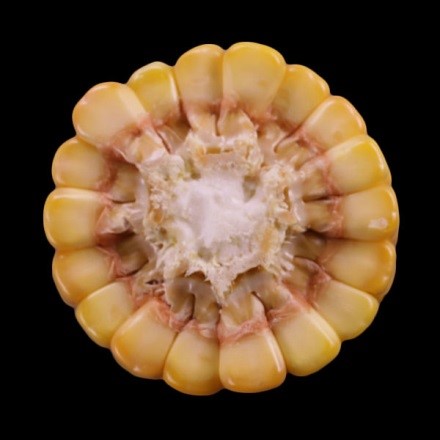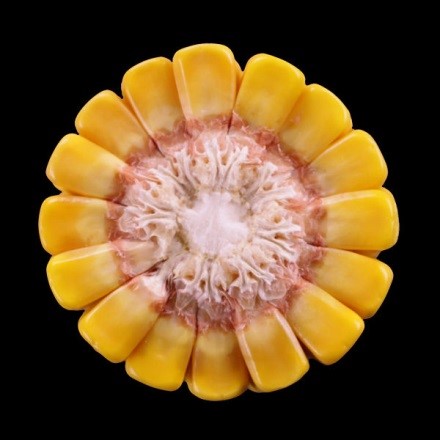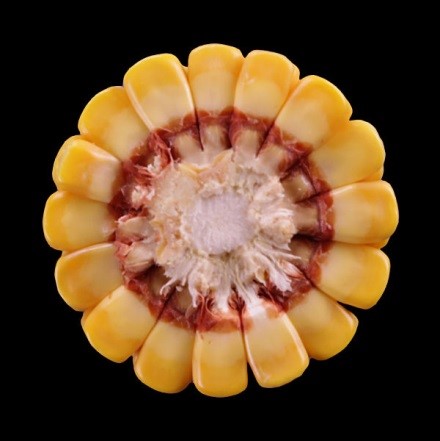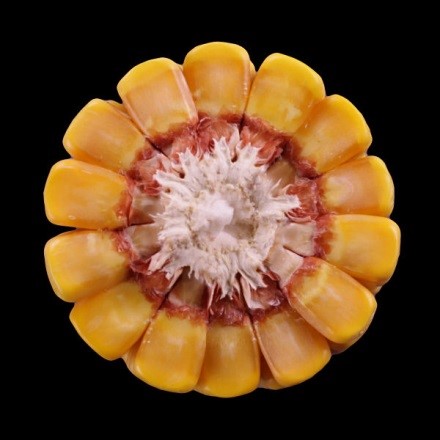Figure 3. Kernel growth stages and approximate grain moisture, GDUs to maturity (black layer or no milk line), and yield loss from a hard, killing frost that stops kernel development.
Corteva Agriscience research indicates that it takes approximately 15 to 20 GDUs to lower grain moisture each point from 30% down to 25%, 20 to 25 GDUs per point of drydown from 25% to 22%, and 25 to 30 GDUs per point from 22% to 20% (Corteva Agriscience, unpublished). If a hard freeze occurs that stops corn development prior to maturity, these field drying rates may be affected. For example, corn frosted as early as the dough stage may require 4 to 9 extra days to reach the same harvest moisture as corn not frosted (Maier and Parsons, 1996).
Grain moisture at harvest affects the time and cost required to dry the grain to acceptable storage moisture levels, as well as grain quality. Wet grain can incur damage during combining, handling and drying. If grain quality is significantly reduced during harvest and drying, allowable storage time is also reduced, dockage may result, and losses of fines and broken kernels can trim bushels of saleable grain.
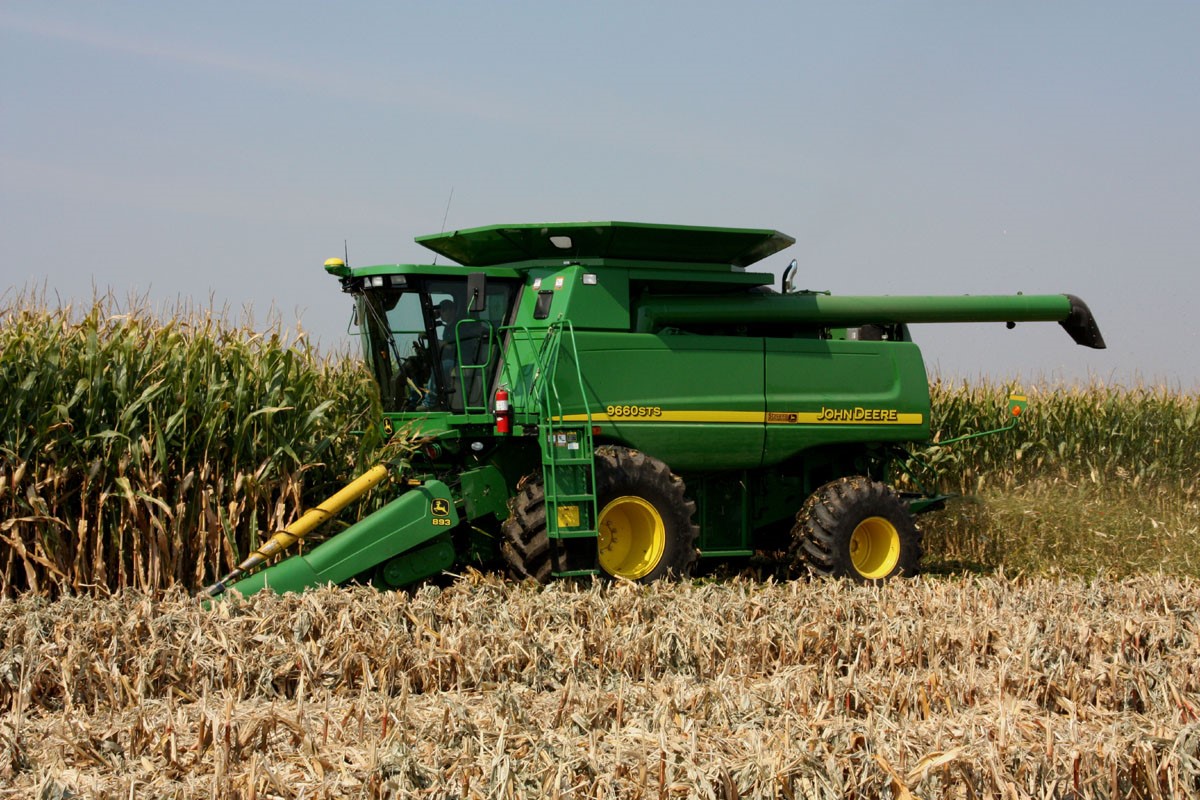
Pre-harvest tips
In seasons with delayed corn crop development, many growers will have to deal with wetter than normal grain at harvest. Several steps can be taken prior to harvest to make this job go more smoothly (Lauer 2009).
- If you have recorded silking dates by field, use these notes to predict the order in which fields will reach black layer and harvestable moisture. This will help in setting up a harvest schedule. However, be sure to base the schedule on crop condition as well as grain moisture, taking into account stalk quality and insect or disease damage.
- Where such options exist locally, consider harvesting (or selling) more of your crop as silage or high moisture corn.
- Explore locking in a price for the additional fuel needed for grain drying. Compare the fuel costs vs. possible dockage for shrink if wet corn is delivered to the elevator.
- Consider some field drying if grain moisture levels are high, but don’t wait too long! Wet field conditions can keep combines out of the field as crops deteriorate, and snow and ice may increase harvest losses due to ear droppage and stalk breakage.
Harvesting wet/immature grain
Combine Adjustments: Grain above 30% moisture can be difficult to remove from the cob and is easily cracked and damaged by over-threshing in the cylinder or rotor of the combine. Cylinder/rotor speed and concave clearance are the adjustments most critical to reduce grain damage and threshing losses. At high grain moisture growers may have to strike a balance between damaged grain and higher than normal grain loss from unshelled cobs.
With very wet grain, some ag engineers suggest beginning harvest with combine settings that would likely under-thresh a typical, lower moisture crop (Brook and Harrigan, 1997):
- Set cylinder/rotor speed near the low end of the suggested range.
- Set concave clearance near the widest recommended setting.
- Open the chaffer and sieve to the maximum recommended openings.
- Check with the combine manufacturer for machine-specific recommendations. (Combine mechanics or other dealership staff are often a good source for this information).
- Begin with above settings but check immediately and re-adjust as necessary to achieve best results. Continue to check and readjust as crop conditions change.
- For more tips on combine settings for wet grain, go to: https://fyi.extension.wisc.edu/grain/files/2009/12/2009CornHarvest2.pdf.
Drying wet/immature grain
Properly drying very wet, lower quality corn is essential to avoid further quality reductions. Growers should screen lower quality grain prior to drying, using a rotary screen, gravity screen or perforated auger housing section. This will help prevent foreign material and broken kernel fragments (or “fines”) from blocking air flow essential to uniform grain drying and storage. Next, growers should plan to dry lower quality grain 1 or 2 points lower than the normal 14 to 15% often recommended for long-term storage. This is because of greater variations of moisture content within the grain mass and increased physical kernel damage and broken cobs, which could magnify mold problems.
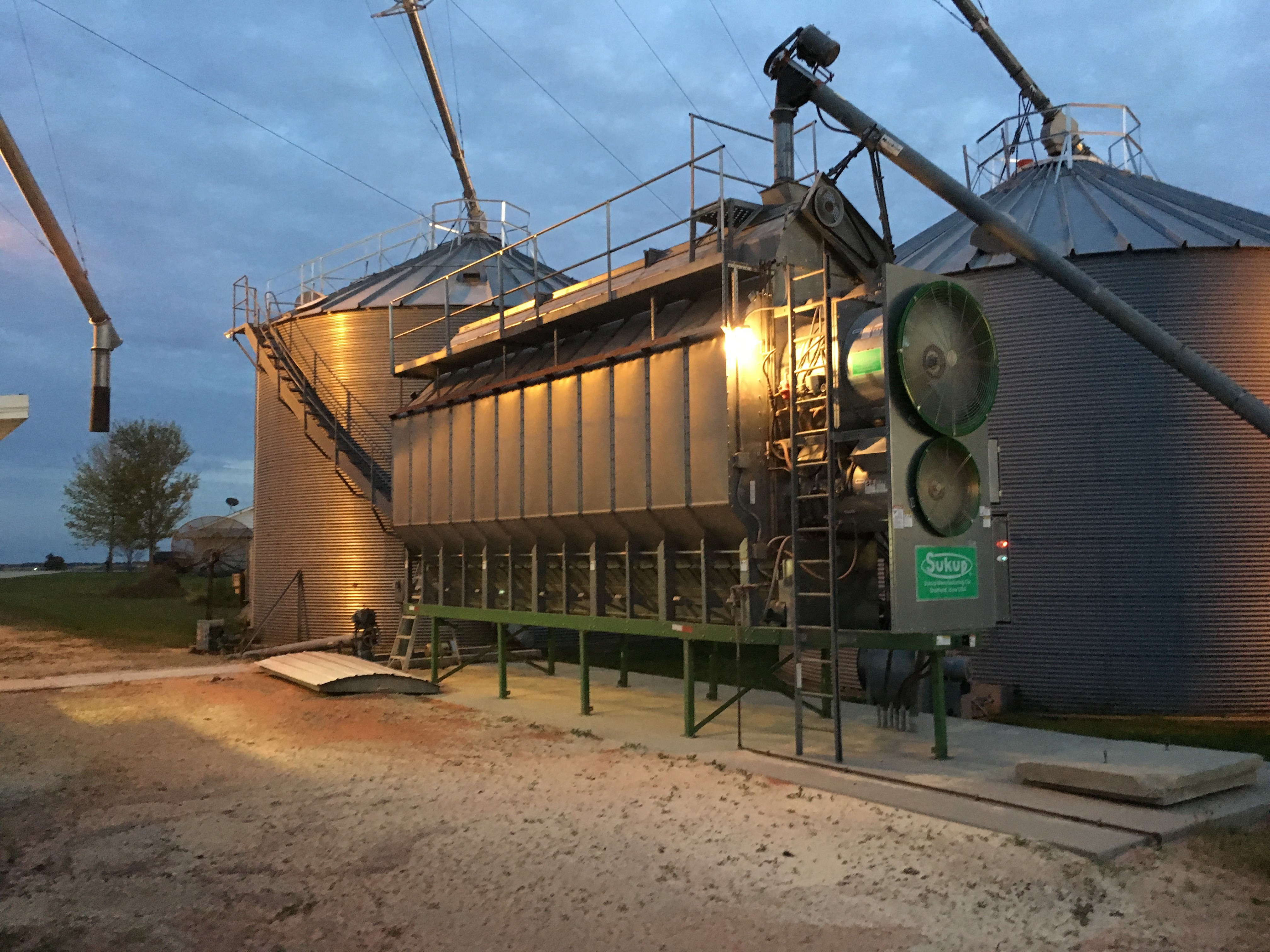
According to extension specialists at North Dakota State University, energy efficiency is increased at maximum temperatures in high temperature drying systems, but these temperatures could scorch very wet or immature kernels. In addition, high temperature drying causes stress cracks in the kernel, which allows more breakage during handling and storage. The amount of stress cracking depends on initial grain moisture, rate of moisture removal, maximum grain temperature reached in the dryer, and rate of grain cooling. Therefore, drying temperatures need to be limited on corn of 25 to 30% moisture content (or higher).
With natural-air or low-temperature drying systems it will be difficult to adequately dry corn wetter than 26% grain moisture. The maximum moisture content for natural air dry-ing of corn is 21 percent using an airflow rate of at least one cubic foot per minute per bushel of corn (Hellevang, 2009).
Consider these investments to help manage harvest, drying, and storing wet, lower-quality grain:
- Moistures tester: $300 to $2000
- “Bee’s wings” and fines cleaner: $1500 to $3000
- Moisture controllers for grain dryer: $2500 to $5000
- Temperature cables in the grain bin: $2500 to $5000
The University of Wisconsin gives these additional grain drying tips (Lauer, 2009):
- Fine-tune your dryer so that over- or under-drying does not occur. Over-heating the grain in the dryer or filling the bin too fast for drying to occur will increase costs and decrease grain quality, thus reducing profitability.
- Hire and train the skilled labor that will be required to monitor dryers, fans, augers, and other equipment during the drying process.
To reduce drying time and speed harvest, some growers have discussed partially drying and aerating corn while holding it for further drying after completion of harvest. This strategy requires skill and intensive management, especially with low-quality grain. For more tips on grain drying to maximize grain quality, see Appendix I.
Storing wet/immature grain
Low test weight, lower quality grain is harder to store because it is breakage-prone and subject to mold and “hot spot” occurrence in the bin. Because the storage life of this grain may be only half that of normal corn at the same moisture content, consider selling this grain early rather than storing long-term.
To minimize storage problems, begin by screen-cleaning grain before binning to remove as much of the fine material, cob pieces and broken kernels as possible. After filling, “core” the bin (remove up to 10% of the total bin capacity) to eliminate broken kernels and fines that accumulate in the center. Next, level the grain in the bin to minimize moisture accumulation at the top of the grain. Finally, cool grain as soon as it is dry to within 10 degrees of air temperature, and continue to aerate for 10 to 14 days to ensure grain moisture “equilibrium” has been achieved.
Monitoring lower quality grain on a twice-monthly basis is essential to ensure that grain condition is maintained. For more tips on grain storage and monitoring procedures, see Appendix I and II.
Conclusions
When growers have fields of wet or immature corn in October, deciding when to start combining is difficult. Experiences during several late harvest years suggest that excessive delays may not be a good idea, for these reasons:
- Delaying starting may also delay finishing at a reasonable date. Most growers require about 6 weeks to harvest the entire crop in a normal year, and another 2 weeks to com-plete fertilization and tillage. This means growers must start the first week of October to finish before December.
- Drying corn with ambient temperature in the 20s requires more energy than drying corn with ambient temperatures in the 40s.
- Harvesting in the winter limits fall tillage and fertilization, reducing options for crop rotation the following spring.
- Finally, there are safety concerns and potential for increased damage to machinery when harvesting on frozen soils and driving on snow or ice-covered roads.
For these reasons, timely harvest is usually advantageous, even though drying costs may be increased.
References
Afuakwa, J.J. and R.K. Crookston. 1984. Using the kernel milk line to visually monitor grain maturity in maize. Crop Sci. 24:687-691.
Brook, R. and T. Harrigan, 1997. Harvesting and handling high moisture, frost-damaged grain. Harvest Alert Fact Sheet #5. Field Crops Team, Michigan State University.
Hellevang, K. 2009. NDSU Extension Service to provide corn drying information at Big Iron. North Dakota State University Extension Service News Release.
Lauer, J. 2004. Guidelines for handling corn damaged by frost prior to grain maturity. In Issues in Agriculture. University of Wisconsin Extension.
Lauer, J. 2009. Will corn mature in 2009? Agronomy Advice – Field Crops 28:491-70. University of Wisconsin Extension.
Maier, D. and Parsons, S. 1996. Harvesting, drying, and storing frost-damaged corn and soybeans. Grain Quality Task Force Fact Sheet #27. Purdue University.
Thomison, P. 2011. Corn drydown: what to expect? Crop Observation and Recommendation Newsletter 2011:34. Ohio State University Extension.
The foregoing is provided for informational use only. Contact your Pioneer sales professional for information and suggestions specific to your operation. Product performance is variable and subject to any number of environmental, disease, and pest pressures. Individual results may vary. Pioneer® brand products are provided subject to the terms and conditions of purchase which are part of the labeling and purchase documents.
Appendix I - Optimal management practices for drying and storage
(John Gnadke, AGS, Inc.)
Continuous Flow Grain Dryers1
|
Operating Plenum Temp.2
|
Grain Temp. Maximum
|
Food Corn
|
130-140 ºF
|
100 ºF
|
Wet Milling Corn
|
170-190 ºF
|
130 ºF
|
Livestock Feed
|
170-190 ºF
|
130 ºF
|
1To maintain high capacity and grain quality, keep your grain dryer clean!
2Temperature ranges must be within 15-20 ºF anywhere within your plenum.
In-Bin Drying
- In-Bin with stirring equipment - for best results, the operating temperature should be 95-105 °F.
- In-Bin with low temp heaters (LP or electric) should be operated on a Humidity Controller. This will condition the ambient air to the proper relative humidity (RH). For best results, the RH setting is approximately 70%.
Natural Air In-Bin
- Fan Size: 1.5 CFM of air per bushel.
- Clean grain to 2% or less BCFM.
- Wet grain moisture: 20% for best results
- Roof Venting: 1.5 sq. ft. per fan HP.
In-Bin Continuous Flow
- Clean Grain to 2% or less BCFM.
- Operating Temp: 130-160 °F.
- Keep grain depth from 4-6 ft for highest capacity of this unit.
- Proper roof vent is a must (1.5 sq. ft. per fan HP).
- Grain discharge temp will be 95-115° F.
In-Bin Cooling
- If stress fractures are a part of a grain contract, take special steps to prevent this from occurring (grain temp: 95-105 ºF).
- If wet grain is 20% or less, steep for 12 hours before cooling.
- If wet grain is 22-24%, steep for 18-24 hours before cooling.
If ambient air temps fall below 40 F at night, then DO NOT operate cooling fans.
- Operating cooling fans at 40 F or above will reduce stress on grain (may require day-time operation of these cooling bins.)
Cooling Grain to Proper Storage Temperatures
- Cool grain to 35 ºF (DO NOT freeze food corn as it can cause additional stress on the grain.)
- Freezing grain at 18-20% moisture can cause ice crystals to form on the kernels.
- When temperature rises in Feb. or March, ice crystals will melt and cause grain to go out of condition very quickly.
Final Note
All stored grain should be checked every two weeks!
Appendix II - Grain storage principles
(John Gnadke, AGS, Inc.)
Initial Storage
- Dry grain to the “equilibrium” moisture level (15%).
- Use LOW temperature drying to minimize stress cracks.
- For ideal grain storage, target 2% cracked/broken.
- Level the grain in the bin to minimize moisture accumulation at the top of the bin (core or use a mechanical “spreader”).
- “Core” the bin by removing 10% of the total bin capacity after filling to remove fines that accumulate in the center. In the coring process try to keep the bin as level as possible.
- Cool grain as soon as it is dry to within 10 degrees of air temperature.
- Aerate the grain for 10 to 14 days after filling to ensure grain “equilibrium” has been achieved – based on ¼ CFM.
- Monitor grain temperature and moisture regularly (minimum every two weeks, preferably on a continuous basis with “in-bin” probes and visual inspection).
- Monitor grain for insect and rodent infestation on a regular basis (minimum every two weeks).
Long-Term Storage
- Keep cooling grain on a regular basis until grain temp reaches 35 °F. Never cool grain below 32 °F.
- Check grain regularly (minimum every two weeks) while in storage.
- Lock out power.
- Climb into the bin, look, feel, smell, and walk on the surface.
- If automated controls are used, bi-weekly inspections are still recommended to ensure controls are functioning properly.
- Aerate on a regular basis while in storage, discontinue fan run-time when temperatures fall below 32 °F.








